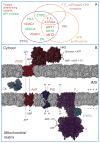Cell biology. Metabolic control of cell death
- PMID: 25237106
- PMCID: PMC4219413
- DOI: 10.1126/science.1250256
Cell biology. Metabolic control of cell death
Abstract
Beyond their contribution to basic metabolism, the major cellular organelles, in particular mitochondria, can determine whether cells respond to stress in an adaptive or suicidal manner. Thus, mitochondria can continuously adapt their shape to changing bioenergetic demands as they are subjected to quality control by autophagy, or they can undergo a lethal permeabilization process that initiates apoptosis. Along similar lines, multiple proteins involved in metabolic circuitries, including oxidative phosphorylation and transport of metabolites across membranes, may participate in the regulated or catastrophic dismantling of organelles. Many factors that were initially characterized as cell death regulators are now known to physically or functionally interact with metabolic enzymes. Thus, several metabolic cues regulate the propensity of cells to activate self-destructive programs, in part by acting on nutrient sensors. This suggests the existence of "metabolic checkpoints" that dictate cell fate in response to metabolic fluctuations. Here, we discuss recent insights into the intersection between metabolism and cell death regulation that have major implications for the comprehension and manipulation of unwarranted cell loss.
Copyright © 2014, American Association for the Advancement of Science.
Figures



References
Publication types
MeSH terms
Substances
Grants and funding
LinkOut - more resources
Full Text Sources
Other Literature Sources

